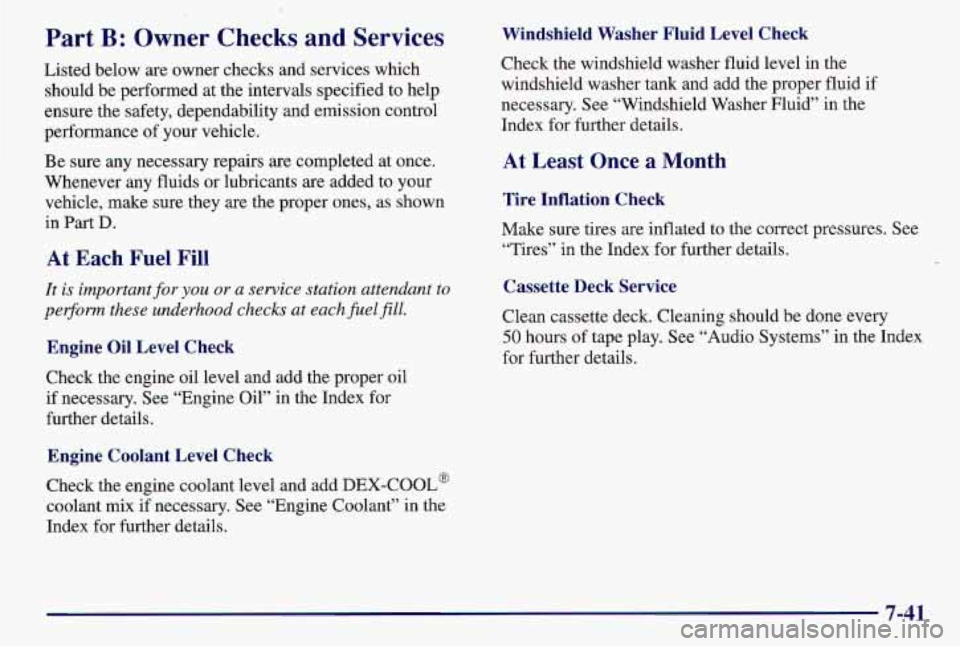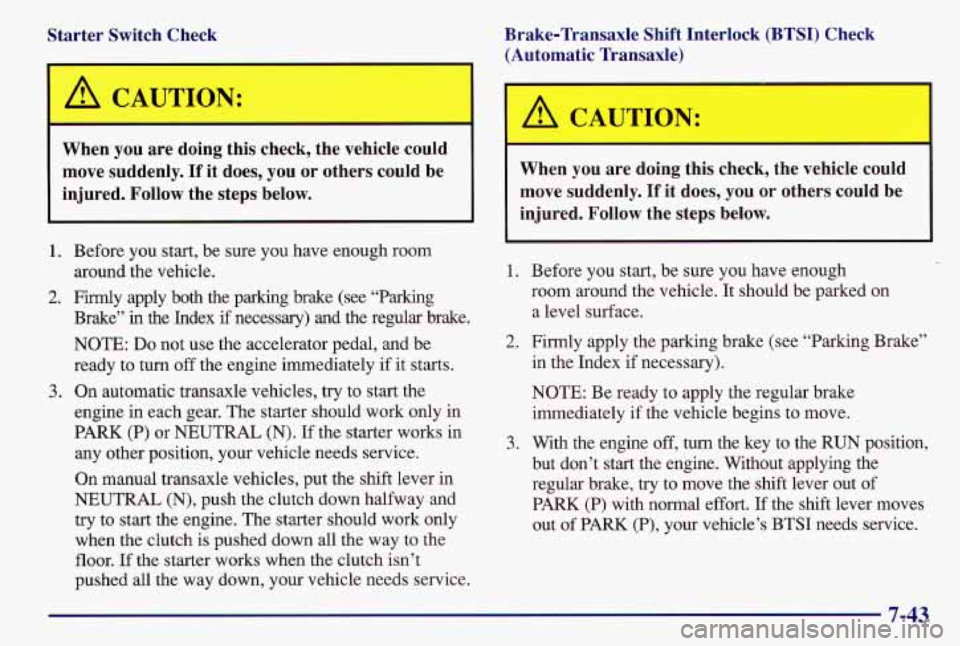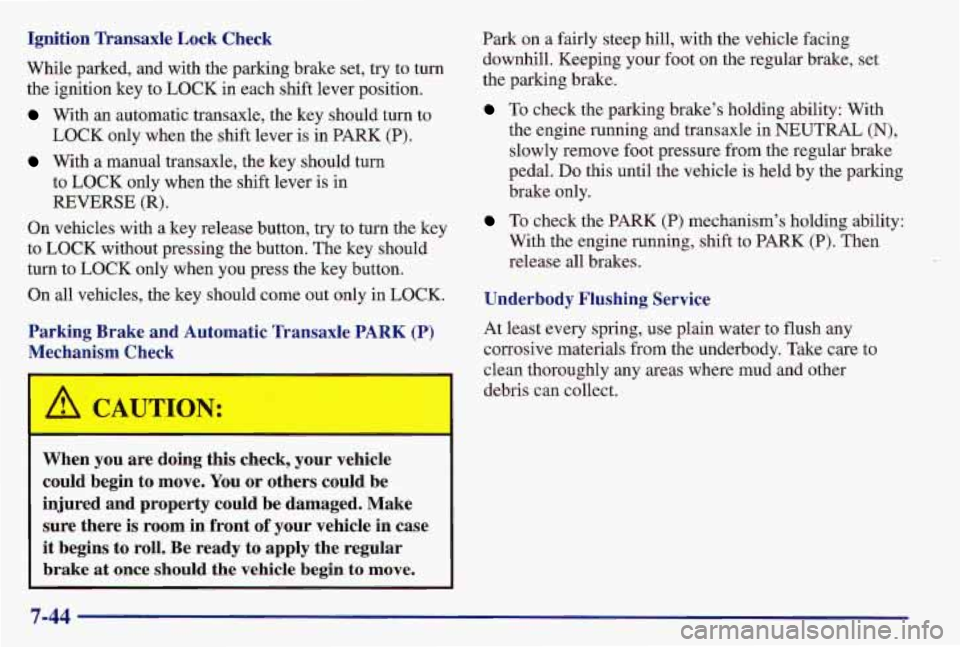Page 329 of 371
I Long Trip/Highway Maintenance Schedule I
67,500 Miles (112 500 km)
0 Change engine oil and filter (or every
12 months, whichever occurs first).
An Emission Control Service.
0 Lubricate chassis components (or every
12 months, whichever occurs first).
(See footnote
#.)
0 Rotate tires. See “Tire Inspection and
Rotation” in the Index for proper rotation
pattern and additional information.
(See footnote
+.)
I DATE I ACTUAL MILEAGE SERVICED BY: I
75,000 Miles (125 000 km)
0 Change engine oil and filter (or every
12 months, whichever occurs first).
An Emission Control Service.
0 Lubricate chassis components (or every
12 months, whichever occurs first).
(See footnote
#.)
0 Rotate tires. See “Tire Inspection and
Rotation” in the Index for proper rotation
pattern and additional information.
(See footnote
+.) (Also see footnote ++.)
-
7-36
Page 330 of 371
I L.ong TriplHighway Maintenance Schedule
82,500 Miles (137 500 km)
0 Change engine oil and filter (or every
12 months, whichever occurs first).
An Emission Control Service.
0 Lubricate chassis components (or every
12 months, whichever occurs first).
(See footnote
#.)
0 Rotate tires. See “Tire Inspection and
Rotation’’ in the Index for proper rotation
pattern and additional information.
(See footnote
+.)
DATE ACTUAL MILEAGE SERVICED BY
90,000 Miles (150 000 km)
0 Change engine oil
and filter (or every
12 months, whichever occurs first).
El Lubricate chassis components (or every
12 months, whichever occurs first).
(See footnote
#.)
An Emission Control Service.
0 Replace air cleaner filter.
An Emission Control Service.
0 Inspect fuel tank, cap and lines for damage
or leaks. Inspect fuel cap gasket for any
damage. Replace parts as needed.
An Emission Control Service. (See footnote?.)
(Continued)
7-37
Page 331 of 371
90,000 Miles (150 000 km)
c] Rotate tires. See “Tire Inspection and
Rotation’’ in the Index for proper rotation
pattern and additional infomation.
(See footnote
+.) (Also see footnote ++.)
DATE SERVICED BY ACTUAL MILEAGE
97,500 Miles (162 500 km)
0 Change engine oil and filter (or every
12 months, whichever occurs first).
An Emission Control Service.
0 Lubricate chassis components (or every
12 months, whichever occurs first).
(See footnote
#.)
0 Rotate tires. See “Tire Inspection and
Rotation” in the Index for proper rotation
pattern and additional information.
(See footnote
+.)
DATE SERVICED BY ACTUAL MILEAGE
Page 332 of 371
100,000 Miles (166 800 km)
0 Inspect spark plug wires
(except
2.4L Code T engine).
An Emission Control Service.
0 Replace spark plugs.
0 Change automatic transaxle fluid and filter
if the vehicle is mainly driven under one or
more
of these conditions:
- In heavy city traffic where the outside
temperature regularly reaches
90 OF
(32 O C) or higher.
An Emission Control Service.
-
In hilly or mountainous terrain.
- When doing frequent trailer towing.
- Uses such as found in taxi, police or
delivery service.
If you do not use your vehicle under any of
these conditions, the fluid and filter do not
require changing.
Manual transaxle fluid doesn’t
require change.
7-39
Page 333 of 371
150,000 Miles (240 000 km)
17 Drain, flush and refill cooling system (or
every 60 months since last service,
whichever occurs first). See “Engine
Coolant” in
the Index for what to use.
Inspect hoses. Clean radiator, condenser,
pressure cap and neck. Pressure test the.
cooling system and pressure cap.
An Emission Control Service.
DATE
SERVICED BY ACTUAL MILEAGE
7-40
Page 334 of 371

Part B: Owner Checks and Services
Listed below are owner checks and services which
should be performed at the intervals specified to help
ensure the safety, dependability and emission control
performance
of your vehicle.
Be sure any necessary repairs are completed at once.
Whenever any fluids or lubricants are added to your
vehicle, make sure they
are the proper ones, as shown
in
Part D.
At Each Fue- - --II
It is important for you or a service station attendant to
per$orm these underhood checks at each fie1
fill.
Engine Oil Level Check
Check the engine oil level and add the proper oil
if necessary, See “Engine Oil” in the Index for
further details.
Engine Coolant Level Check
Check the engine coolant level and add DEX-COOL@
coolant mix if necessary. See “Engine Coolant’’ in the
Index for further details.
Windshield Washer Fluid Level Check
Check the windshield washer fluid level in the
windshield washer tank and add the proper fluid
if
necessary. See “Windshield Washer Fluid” in the
Index for further details.
At Least Once a Month
Tire Inflation Check
Make sure tires are inflated to the correct pressures. See
“Tires” in the Index for further details.
Cassette Deck Service
Clean cassette deck. Cleaning should be done every
50 hours of tape play. See “Audio Systems” in the Index
for further details.
7-41
Page 336 of 371

Starter Switch Check
A CAUTION: ,
I
When you are doing this check, the vehicle could
move suddenly.
If it does, you or others could be
injured. Follow the steps below.
1.
2.
3.
Before you start, be sure you have enough room
around the vehicle.
Firmly apply both the parking brake (see “Parking Brake”
in the Index if necessary) and the regular brake.
NOTE:
Do not use the accelerator pedal, and be
ready to turn off the engine immediately if
it starts.
On automatic transaxle vehicles, try
to start the
engine in each gear. The starter should work only in
PARK
(P) or NEUTRAL (N). If the starter works in
any other position, your vehicle needs service.
On manual transaxle vehicles, put the shift lever in
NEUTRAL
(N), push the clutch down halfway and
try to start the engine. The starter should work only
when the clutch is pushed down all the way to the
floor.
If the starter works when the clutch isn’t
pushed all the way down, your vehicle needs service.
Brake-Transaxle Shift Interlock (BTSI) Check
(Automatic Transaxle)
A CAUTION:
When you are doing this check, the vehicle could
move suddenly. If
it does, you or others could be
injured. Follow the steps below.
1. Before you start, be sure you have enough
room around the vehicle.
It should be parked on
a level surface.
2. Firmly apply the parking brake (see “Parking Brake”
in the Index if necessary).
NOTE: Be ready to apply the regular brake
immediately if the vehicle begins to move.
3. With the engine off, turn the key to the RUN position,
but don’t start the engine. Without applying the
regular brake, try to move the shift lever out
of
PARK (P) with normal effort. If the shift lever moves
out of PARK (P), your vehicle’s BTSI needs service.
7-43
Page 337 of 371

Ignition Transaxle Lock Check
While parked, and with the parking brake set, try to turn
the ignition key to LOCK in each shift lever position.
With an automatic transaxle, the key should turn to
LOCK only when the shift lever is in PARK
(P).
With a manual transaxle, the key should turn
to LOCK only when the shift lever is in
REVERSE (R).
On vehicles with a key release button, try to turn the key
to LOCK without pressing the button. The key should
turn to LOCK only when you press the key button.
On all vehicles, the key should come out only in LOCK.
Parking Brake and Automatic Transaxle PARK (P)
Mechanism Ck :k
A CAUTION:
When you are doing this check, your vehicle
could begin to move. You or others could be
injured and property could be damaged. Make
sure there
is room in front of your vehicle in case
it begins to roll. Be ready to apply the regular
brake at once
should the vehicle begin to move.
Park on a fairly steep hill, with the vehicle facing
downhill. Keeping your foot on the regular brake, set
the parking brake.
To check the parking brake's holding ability: With
the engine running and transaxle in NEUTRAL
(N),
slowly remove foot pressure from the regular brake
pedal.
Do this until the vehicle is held by the parking
brake only.
To check the PARK (P) mechanism's holding ability:
With the engine running, shift to PARK (P). Then
release all brakes.
Underbody Flushing Service
At least every spring, use plain water to flush any
corrosive materials from the underbody. Take care to
clean thoroughly any areas where mud and other
debris
can collect.
7-44